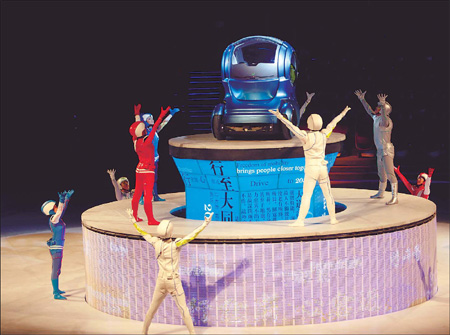China fuels ahead
 |
| Performers dance with the EN-V concept electric vehicle during a show at the SAIC-GM pavilion at the 2010 World Expo site in Shanghai. |
Forget the space race. The commercialization of fuel-cell vehicles may have a bigger impact on the future of our planet, while this technology, which compresses hydrogen at high pressure, is safer on land than it is in the sky, domestic manufacturers say.
As such, the Expo 2010 Shanghai is gearing up as a testing ground for automakers as China aims to commercialize an environmentally friendly technology that gives developing countries the chance to catch up with, or overtake, other economies reliant on oil.
A total of 196 fuel-cell vehicles roam the Expo's streets, comprising of six shuttle buses, 90 cars and 100 green-and-white sightseeing buggies. For fuel, they rely on an electrochemical reaction involving hydrogen and oxygen that produces electricity and water but no harmful emissions.
Proponents claim several advantages over battery-operated vehicles, including better energy-conversion rates, less waste and a smoother ride, as fuel cells don't vibrate.
"We are testing the performance of almost 200 fuel-cell vehicles during the Expo to prepare for the next level of development," said Yu Zhuoping, director of the School of Automotive Engineering at Shanghai's Tongji University. The school has been working with local automakers and joint ventures on this project for almost a decade.
"When we talk about traditional vehicles, our technology (in China) is maybe 30 years behind the West, so now we have put a strong emphasis on clean-energy vehicles because this is an area where China can move in step with the rest of the world," he said.
"The Shanghai Expo is an opportunity for us to verify our technology while raising awareness among the public by letting them touch it," said Tong Zhang, general manager of Shanghai FCV Powertrain Co, Ltd. The company is working with Yu's team at Tongji to build and test fuel-cell prototypes.
The Expo has become the latest battleground in the war against carbon dioxide-emitting gas guzzlers as China waits to see if fuel cells can compete with the internal combustion engine, electric or battery-operated cars and hybrids within as little as five years.
"There are no concrete plans to go commercial with fuel-cell cars yet. The technology isn't ready, but we expect it to happen within the next five to 10 years," said Zhang, who worked in the German auto industry for over a decade.
"I don't want to say we're No 1 in the world, but I can say we're in the leading stage compared with our competitors. We have our own technology, culture and advantages, and they have theirs. GM and Daimler have a better power-performance ratio than us, for example, but in the field of costs, ours are just one-tenth of theirs."
The government is heavily promoting clean energy these days as part of the Expo's "Better City, Better Life" motto. China announced last year that it aims to become a leading producer of hybrid and all-electric vehicles by 2012. On Tuesday, the Ministry of Finance released a list of five trial cities in which buyers of electric and hybrid cars will soon be able to receive subsidies of up to 60,000 yuan for each vehicle they purchase.
According to the ministry's website, the subsidies will be incorporated into the selling price of the vehicles. The government will also provide funds to build charging stations and battery recovery networks in these cities, which include Shanghai, neighboring Hangzhou and Shenzhen, it said.
Meanwhile, Germany's Daimler signed a deal with Chinese battery maker BYD last week to form a joint venture to build an electric car for the China market based on an investment of 600 million yuan. BYD already has two such vehicles on the market, a plug-in hybrid called the F3DM and its E6 electric car. But neither have yet come close to cashing in the electric gold rush the China market could harvest, with foreign carmakers predicting it will take at least another decade before the battery technology gets to a point where mainstream use would be realistic.
Experts say greenhouse gas emissions could be trimmed by at least 20 percent if gas-powered vehicles were replaced with electric cars. Urban smog would not totally disappear, due largely to China's heavy reliance on coal to feed its people's energy needs, but it would dissipate.
The burnt hydrogen from fuel-cell "stacks" is relatively clean and emission-free, but building an infrastructure that facilitates their widespread use is the main stumbling block for economies looking to adopt this new technology.
"The biggest problem in terms of commercializing this technology is building operable and practical refueling stations," Yu said during a tour of the Clean Energy Demonstration Base for the World Expo in Shanghai's Jiading district.
At the demonstration base, a team of experts tracks the movements of each Expo buggy in real time on computer screens while scanning for bugs, kinks and ways of saving costs en route to carving a new business niche.
The base, in Anting town, Jiading, produced its first fuel-cell vehicle in 2002. Called "Start 1", the car now sits in the showroom like a prop at Universal Studios' Back to the Future ride. Anting has been dubbed an international automotive town as it hosts scores of manufacturing and development bases for industry giants like Honda.
 0
0 








Go to Forum >>0 Comments